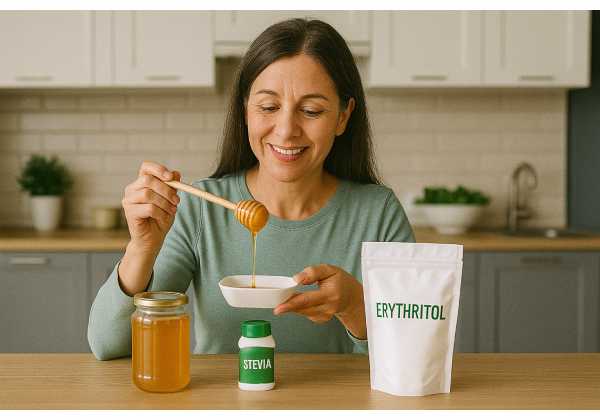
Finding a livable balance with sweetness becomes more important with age. Blood sugar regulation can drift, taste sensitivity shifts, and dental or digestive concerns emerge. That does not mean dessert disappears or your coffee must taste austere. It means choosing sugars and sweeteners with a clearer plan: how much, which types, and in what context. This guide explains what separates honey, stevia, and erythritol from table sugar and high fructose corn syrup; how different sweeteners influence appetite, glucose, and the gut; and where the dose line sits for gastrointestinal comfort. You will also find practical swaps for baking and beverages, plus strategies to gradually reset a preference for less sweetness without feeling deprived. If you are building broader habits for long-term health, pair these tactics with core patterns outlined in our pillar on nutrition for longevity fundamentals.
Table of Contents
- Added Sugar Guidelines and Why They Matter for Aging
- Natural, Artificial, and Sugar Alcohols: What Differs
- Glycemic Impact and Appetite Effects in Real Life
- GI Tolerance: Bloating, Laxation, and How to Avoid It
- Smart Swaps for Baking, Beverages, and Snacks
- Retraining a Sweet Palate without Feeling Restricted
- When Certain Sweeteners Are Not Appropriate
Added Sugar Guidelines and Why They Matter for Aging
“Added sugars” are sugars put into foods and drinks during processing or at the table—cane and beet sugar, syrups, honey used as an added ingredient, and concentrates used to sweeten. For healthy aging, two questions steer decisions: how much sugar fits your day, and what do you trade when sugar climbs? Most adults thrive by keeping added sugars under ten percent of total calories. On a 2,000-calorie pattern, that’s less than 200 calories from added sugars (about 50 g or 12 teaspoons). Many older adults do even better with a lower ceiling—often closer to 6–8 percent—because calorie needs decline while protein, fiber, and micronutrient needs remain steady or increase. A smaller sugar budget protects room for foods that deliver protein (muscle health), calcium and vitamin D (bone), and polyphenols and fiber (cardiometabolic health).
What does ten percent look like in common foods? It’s roughly the sugar in one 12-ounce regular soda (about 35–40 g) plus a sweetened yogurt (10–15 g), or two generous bakery cookies (24–30 g). Because many packaged items hide sugar in small serving sizes, reading the “Added Sugars” line on the Nutrition Facts panel is non-negotiable. If a staple contributes more than 8–10 g added sugar per serving and you eat it daily, consider a lower-sugar brand or a plain version you can sweeten yourself.
Why it matters with age:
- Metabolic drift: Insulin sensitivity tends to decline. Meals with frequent added sugars can push average glucose higher and widen post-meal spikes—stressors linked to cardiovascular and cognitive health over decades.
- Dental health: Dry mouth and recession are more common with age. Sticky sweets and frequent sipping of sweetened beverages increase caries risk.
- Appetite trade-offs: Sugar increases palatability and can crowd out protein and fiber when the calorie budget is tight.
- Triglycerides and liver fat: High-sugar patterns, particularly from sugar-sweetened beverages, raise triglycerides and can promote fatty liver in susceptible people.
Instead of an all-or-nothing rule, apply a “budget and anchor” approach. Budget how many grams of added sugar you want to spend each day (e.g., 25–40 g), then anchor each meal with protein and produce. If dessert is part of your day, make room by trimming sugar elsewhere rather than stacking sweets on top of already sufficient calories. Finally, emphasize total diet quality: a cup of plain yogurt with berries and a drizzle of honey lands differently than the same sugar from a soda because the matrix includes protein, minerals, and fermentation by-products that help with satiety and metabolic response.
Natural, Artificial, and Sugar Alcohols: What Differs
Sweeteners fall into three practical families: nutritive sugars, non-nutritive high-intensity sweeteners, and sugar alcohols (polyols). Understanding how they differ helps you choose the right tool for the job.
1) Nutritive sugars (calories and glucose impact).
These include table sugar (sucrose), glucose, fructose, high fructose corn syrup, maple syrup, and honey. They provide roughly 4 kcal per gram and raise blood glucose to varying degrees. Honey brings small amounts of phytochemicals and aromas that can make smaller amounts feel more satisfying. But metabolically, a tablespoon of honey (about 17 g, ~70 kcal) still counts as added sugar when used to sweeten foods.
2) Non-nutritive high-intensity sweeteners (very sweet, near-zero calories).
These compounds deliver sweetness hundreds of times stronger than sugar, so you use tiny amounts:
- Stevia (steviol glycosides; often reb A) comes from the stevia leaf. Many retail products blend stevia with erythritol or inulin to improve taste and bulk.
- Sucralose and acesulfame potassium are synthetic, heat-stable options common in baking mixes and beverages.
- Aspartame is widely used in diet sodas and tabletop packets; it is not heat-stable in high-temperature baking.
High-intensity sweeteners do not add significant calories and have minimal direct glycemic effects. Taste quality differs—some people notice bitterness or licorice notes with stevia; sucralose can taste “clean” in beverages but bake differently than sugar.
3) Sugar alcohols (polyols; low-digestible carbohydrates).
Erythritol, xylitol, sorbitol, maltitol, and isomalt provide less energy (0.2–3 kcal/g) because the small intestine absorbs them poorly, and they reach the colon where microbes ferment them. Erythritol is an exception: it is mostly absorbed in the small intestine and excreted in urine, so it is typically better tolerated than other polyols and contributes almost no calories. Polyols supply bulk and texture, so they often replace sugar in “no-sugar-added” chocolates, candies, and cookies.
Label clues and combinations.
Products frequently combine one high-intensity sweetener with a polyol (for bulk) and flavor modulators to round off aftertastes. When you see “stevia” on the front and erythritol or inulin high in the ingredients list, you are handling a blend, not pure stevia. “No added sugar” does not mean no sweetness; it can signal polyols or fruit concentrates.
Choosing by use case:
- Daily beverages: Stevia or sucralose drops can reduce sugar intake with little effort.
- Baking texture: Polyols add bulk; erythritol-based blends or allulose (a rare sugar, not a polyol) can approximate sugar’s structure better than stevia alone.
- Dental health: Xylitol gum supports salivary flow and is non-cariogenic; keep away from pets, as xylitol is toxic to dogs.
- Dessert you truly taste: Honey or maple syrup can be used in modest amounts for flavor intensity. Measure, do not drizzle freely.
If you are also dialing in desserts more broadly, see simple tactics in our guide to lighter dessert choices.
Glycemic Impact and Appetite Effects in Real Life
Sweetness interacts with appetite in two ways: the physiologic response (glucose and insulin dynamics) and the behavioral response (how sweetness shapes future choices). Both matter for long-term health.
Glycemic response.
Nutritive sugars raise blood glucose proportionally to dose and context. A sweetened beverage taken without protein or fiber tends to produce a quicker spike than the same sugar eaten with yogurt, nuts, or whole grains. Honey’s glycemic impact varies by floral source and processing; in practice, tablespoon-for-tablespoon, it behaves like other sugars but may be used in smaller amounts because of its aroma and acidity. Stevia, sucralose, and similar high-intensity sweeteners do not raise blood sugar directly at typical doses. Erythritol has near-zero glycemic impact; xylitol and maltitol have small to moderate effects depending on the amount and what they are paired with. For people using continuous glucose monitors, test a few “usual” sweet foods against alternatives to see how your body responds in context—breakfast vs. afternoon, alone vs. with protein.
Appetite and total energy intake.
At the level of daily choices, replacing sugar-sweetened beverages with versions sweetened by high-intensity sweeteners often lowers total calories. People tend to compensate modestly (eating a bit more later), but not enough to cancel the calorie difference. When non-nutritive sweeteners replace water, appetite effects are mixed: some individuals snack more, others eat the same or less. As a practical rule, use sweetened zero-calorie beverages as a bridge away from sugar, not as a license to add extra dessert.
Taste learning and reward.
The brain learns a tight link between sweet taste and rapid energy. With repeated exposure to very sweet beverages or desserts, the threshold for “sweet enough” can drift upward. That is reversible. Decreasing sweetness in small steps—reducing packet counts in coffee or using half the sweetener in recipes—resets expectations in weeks. Pair sweetness with protein or fiber to flatten post-meal dips that can trigger cravings.
Honey vs. “diet” alternatives.
Honey can fit in a longevity-focused pattern when you measure it, use it as a flavor accent, and anchor meals with protein and produce. Non-nutritive sweeteners and polyols are useful tools to reduce sugar load, especially for beverages and occasional baking—just observe your own appetite response. If you are also targeting steadier post-meal curves, our primer on taming post-meal spikes explains how to structure meals so sweetness is less destabilizing.
Practical checkpoints:
- Use volume control: dilute juice 1:1 with sparkling water; choose small dessert portions.
- Pair sweets with protein and fiber: yogurt and berries; nuts with fruit.
- Track your personal curve for two weeks: note which sweet choices lead to extra snacking vs. satisfaction.
GI Tolerance: Bloating, Laxation, and How to Avoid It
The gut responds to sweeteners in different ways. Knowing your dose threshold and trigger types helps you enjoy sweetness without discomfort.
Sugar alcohols (polyols) drive most symptoms.
Because the small intestine absorbs polyols incompletely, water follows them into the gut and microbes ferment what reaches the colon. The result can be gas, bloating, and laxation—stronger with higher doses and when polyols are combined. Tolerance varies widely:
- Erythritol: Usually best tolerated because it is mostly absorbed and excreted unchanged. Many people tolerate up to 0.4–0.7 g/kg body weight per day split across meals (about 30–50 g for a 70-kg adult), though large single servings in cold beverages can still cause rumbling.
- Xylitol and isomalt: Moderate tolerance; 10–20 g in a single sitting can bother some people, especially in low-fiber meals.
- Sorbitol and maltitol: More fermentable and commonly problematic; candies and “no-sugar-added” chocolates made with maltitol often cause urgent stools in sensitive individuals.
High-intensity sweeteners rarely cause laxation.
Stevia, sucralose, and acesulfame potassium do not typically cause bloating at common doses. If a product with these sweeteners bothers you, check for inulin, oligofructose, or erythritol in the ingredient list—those may be the real culprits. Inulin and related fibers have prebiotic benefits, but abrupt large doses can cause gas before your microbiota adapts.
Honey and the FODMAP context.
Honey contains fructose and small amounts of other fermentable carbohydrates. For some people with irritable bowel syndrome (IBS), a tablespoon or more can trigger symptoms, especially when combined with other FODMAP-rich foods in the same meal (apples, pears, wheat, onions). If you use a low-FODMAP approach, keep honey modest and spread across meals.
How to find your tolerance:
- Map the ingredients. If a product lists maltitol, isomalt, or sorbitol near the top, expect a lower threshold. If it lists erythritol first, tolerance is usually higher.
- Dose by halves. Start with half the labeled serving; assess comfort before scaling. Many bars and chocolates label “one bar” as a serving that includes 15–25 g total polyols—too much for some.
- Pair with food. Polyols are better tolerated with a mixed meal than on an empty stomach.
- Space your sweets. Small amounts across the day beat one large bolus.
- Adjust your fiber base. A consistent intake of soluble fiber (oats, beans, chia) improves tolerance over time.
If you are also improving overall gut health, see our primer on polyphenols, fiber, and ferments to support a more resilient microbiome while you refine sweetener choices.
Smart Swaps for Baking, Beverages, and Snacks
You can lower added sugar without losing pleasure by matching the function of sugar in a recipe—sweetness, bulk, browning, and moisture—and choosing tools that replace each function thoughtfully.
Beverages
- Coffee and tea: Reduce packet counts gradually. If you use two packets of sugar (8 g), try one packet plus a dash of cinnamon. For zero-calorie options, stevia drops or sucralose tablets dissolve cleanly in hot drinks.
- Fizz with less sugar: Mix 3–4 oz fruit juice with sparkling water and a squeeze of citrus. If you prefer flavored seltzer, a few ice cubes spun with frozen berries add aroma without sugar.
- Smoothies: Use frozen banana for body, then limit added sweetener. A scoop of plain yogurt or silken tofu improves texture and satiety.
Baking
- Bulk and browning: Sugar adds structure and color. Replacing 25–50 percent of sugar with erythritol-based blends or allulose preserves texture better than stevia alone. Reserve a small amount of real sugar or honey (10–25 percent of the original) to maintain browning and moisture.
- Moisture and flavor: Applesauce, mashed banana, pumpkin, or ricotta add moisture so you can cut sugar further. Vanilla, espresso powder, orange zest, and warm spices (cinnamon, cardamom) intensify perceived sweetness.
- Recipe-by-recipe targets:
- Quick breads and muffins: Reduce sugar by 25–40 percent; replace some with fruit puree and a small splash of honey for aroma.
- Cookies: Swap 30–50 percent of sugar with erythritol/allulose; keep a tablespoon of real sugar per dozen for spread and crackle.
- Cakes: Use buttermilk or yogurt for tenderness; combine 70 percent erythritol-blend with 30 percent sugar to avoid dryness.
Snacks and desserts
- Yogurt parfait: Start with plain Greek yogurt, add berries, and drizzle a measured teaspoon of honey (about 5–7 g sugar).
- Chocolate craving: Choose 70–85 percent dark chocolate (lower sugar) or small portions of no-sugar-added bars that use erythritol or allulose. Test tolerance first.
- Fruit-forward desserts: Baked apples or pears with nuts and oats need minimal added sugar because heat concentrates sweetness.
- Frozen treats: Blend frozen banana, cocoa, a splash of milk, and peanut butter. If needed, add one or two drops of stevia rather than a tablespoon of syrup.
Everyday planning
- Default breakfast: Unsweetened base (oats, eggs, yogurt) plus fruit—easy to replicate and low in added sugar.
- Restaurant strategy: Sauces and glazes hide sugar. Ask for them on the side; choose grilled entrees and a fruit-based dessert to share.
- Packaging scan: Aim for snacks with ≤5–7 g added sugar per serving. For bars, watch polyol totals and start with half.
If you meal prep, you can lock in low-sugar defaults and save your “sugar budget” for treats you truly enjoy. For a modular system that scales, see our guide to batch cooking for longevity.
Retraining a Sweet Palate without Feeling Restricted
Taste is trainable at any age. Most people can lower their sweetness threshold in three to six weeks with small, steady shifts. The goal is not austerity—it is preference drift toward “pleasantly sweet” rather than “high-octane sweet.”
Principles that work
- Step down, do not jump. Reduce sweetener or sugar by 10–20 percent each week in coffee, tea, and breakfast staples. A gradual approach avoids the “this tastes wrong” reaction that leads to rebound.
- Sweetness after fullness. Put sweet flavors after you have eaten protein and fiber. A square of dark chocolate or fruit after dinner satisfies with less.
- Anchor your first meal. A lower-sugar, higher-protein breakfast (e.g., eggs with vegetables, or yogurt with nuts and berries) tends to reduce afternoon sugar cravings.
- Use scent and temperature. Warm spices, citrus zest, and vanilla trick the brain toward perceiving sweetness. Serving desserts warm releases aromas; serving drinks very cold slightly blunts sweetness—adjust expectations accordingly.
- Audit your environment. Keep high-sugar snacks out of sight; keep fruit, nuts, and plain yogurt visible. What is convenient wins.
- Name your “worth it.” List three desserts you truly love. Plan them. Skip mindless sweets that only rate a five out of ten.
A three-week reset outline
- Week 1: Cut beverage sweeteners by 20 percent. Swap one daily sweetened yogurt for plain with fruit.
- Week 2: Replace two desserts with fruit-plus-protein (e.g., berries and ricotta). Bake one favorite using 30 percent less sugar and extra vanilla.
- Week 3: Move soda or sweet tea to once per week; make seltzer with 3 oz juice your default. Choose one “celebration dessert” and enjoy it mindfully.
Mindset and momentum
Track two results: energy stability (fewer afternoon slumps) and taste change (how sweet a previously normal item now tastes). Expect your palate to recalibrate; many people find flavored yogurt or commercial cookies taste overly sweet after a few weeks. If sugar cravings show up late afternoon, review earlier meals for missed protein or fiber, or for long gaps between meals. For additional tools to steady appetite and reduce “sweet seeking,” see strategies in craving control for healthy aging.
When Certain Sweeteners Are Not Appropriate
Sweeteners are not interchangeable for everyone. Consider these situations and choose with safety in mind.
1) Diabetes, prediabetes, and insulin resistance.
Lowering added sugar—especially from drinks—improves glycemic control for most people. High-intensity sweeteners can help reduce sugar load. Still, monitor your behavioral response: some individuals snack more when they rely on sweetened diet drinks. Pair zero-calorie sweeteners with a steady meal pattern high in protein and fiber. If you use honey, measure it and place it within balanced meals rather than as frequent “add-ons.” People using insulin or sulfonylureas should be alert to hypoglycemia when overall carbs trend downward; discuss medication adjustments with your clinician.
2) Elevated triglycerides, fatty liver, and heart risk.
Sugar-sweetened beverages raise triglycerides and can worsen fatty liver. They are a high-impact target to reduce. For polyols, consider moderation if you have known gastrointestinal sensitivity; aim for erythritol-based blends in small amounts and monitor overall diet quality. If you have established cardiovascular disease or very high risk, be cautious with frequent large intakes of erythritol-sweetened products until more outcome data are available. Occasional small uses in recipes are different from daily large-dose consumption.
3) Irritable bowel syndrome and functional GI disorders.
Polyols clustered in the same meal (protein bars, no-sugar-added candies, and “keto” baked goods) commonly trigger bloating or diarrhea. Start with tiny amounts, pair with meals, and prefer erythritol over maltitol or sorbitol if you choose polyols. Honey can be a FODMAP trigger; small amounts with meals may be tolerated while larger amounts on an empty stomach are not.
4) Phenylketonuria (PKU).
Avoid aspartame because it supplies phenylalanine.
5) Renal stones and kidney disease.
There is no blanket ban on non-nutritive sweeteners, but packaged “keto” treats often combine polyols with high doses of vitamin C or oxalate-rich ingredients (nuts, cocoa). If you form calcium oxalate stones, watch total oxalate and keep fluid intake high.
6) Dental concerns and dry mouth.
Sticky sweets and frequent sipping bathe teeth in sugar. Choose xylitol gum or lozenges to stimulate saliva after meals, prioritize dark chocolate or fruit over caramels, and concentrate sweets with meals, not grazing.
7) Medication interactions and allergies.
Some liquid medications use sorbitol as a vehicle and can compound GI symptoms when added to a polyol-rich diet. Rarely, individuals report reactions to specific sweetener blends; note the brand and all ingredients, not only the headline sweetener.
Putting it all together:
- Keep added sugars under your daily budget.
- Use non-nutritive sweeteners as tools, not crutches.
- Treat polyols with respect for your unique dose threshold.
- Favor whole-food meals that make sweets optional rather than necessary.
References
- Dietary Guidelines for Americans, 2020-2025 2020 (Guideline)
- Use of non-sugar sweeteners: WHO guideline 2023 (Guideline)
- The artificial sweetener erythritol and cardiovascular event risk – PubMed 2023 (Observational Study and Mechanistic Work)
- The effects of non-nutritive sweeteners on energy and macronutrients intake in adults: a grade-assessed systematic review and meta-analyses of randomized controlled trials – PubMed 2024 (Systematic Review and Meta-analyses)
- A Systematic Review of the Effects of Polyols on Gastrointestinal Health and Irritable Bowel Syndrome – PMC 2017 (Systematic Review)
Disclaimer
This article is educational and does not replace personalized medical advice. Sweetener tolerance and metabolic responses vary, especially with diabetes, IBS, kidney disease, cardiovascular disease, or when taking medications that affect appetite, digestion, or glucose control. Discuss diet changes with your healthcare professional if you have chronic conditions or symptoms such as unexplained weight loss, persistent abdominal pain, or recurrent hypoglycemia.
If you found this guide useful, please consider sharing it on Facebook, X, or your preferred platform, and follow us for future updates. Your support helps us continue creating evidence-based resources for healthy aging.










